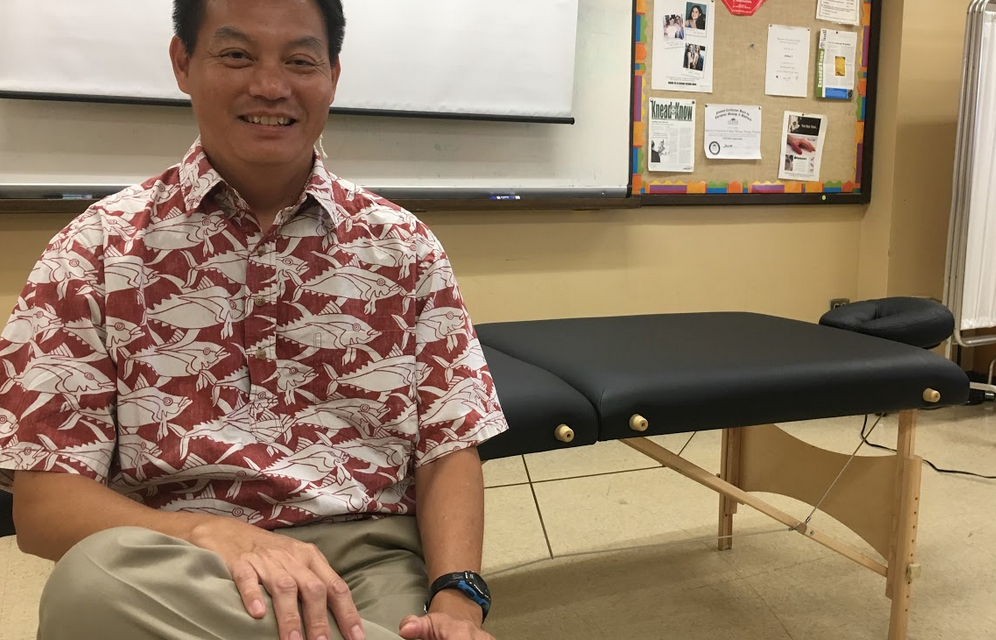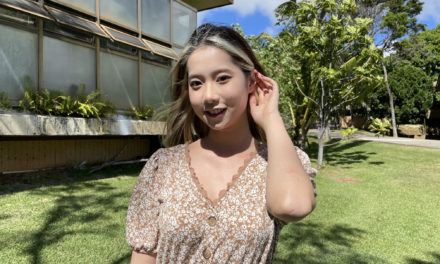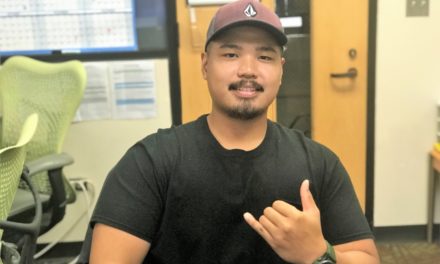By Katlin Cilliers | Staff Writer
Ask a Professor is a regular feature in which the Kapiʻo News will highlight the real-life careers and jobs that stem from areas of study at Kapiʻolani Community College.
Professor Martin Chong was a freshman at the University of Hawaiʻi at Mānoa when he realized that he didn’t want to pursue engineering , and instead, wanted a career in human services. His choices led him to a bachelor’s in Psychology, followed by a master’s degree in Educational Counseling. Upon finishing graduate school, he decided to help people in further ways than just mentally and emotionally. He became licensed through a Massage Therapy Program through the Hawaiʻi College of Health Sciences in 2000.
Chong has been working in the UH system for 18 years, where he started in the Department of Health Sciences at KCC. Today, he is the head of the student clinic for KCC’s Massage Therapy Program, where he also teaches Introduction to Massage (HLTH 3801) and Trigger Point Therapy (HLTH 3853).
How did you become a massage therapist?
I was … a freshman at the University of Hawaiʻi at Mānoa. But I quickly found that [Engineering] wasn’t the major I really wanted to go into, I kinda just followed the path of my friends. I was sort of lost, with being a first-generation college student and things like that. … I was worried about grades, I wasn’t doing so well … and with the neck tension going on, all the muscles got really really tight. So I had neck spasms, and this led to, like, headaches, chronic headaches, dizziness. … So of course I went to get them checked out with my doctor, and they didn’t find anything. Then I went to a chiropractor, and they couldn’t find anything either.
Then I started to kind of massage myself, on all these tight areas. … I started to really think about what I’d do in life, and I chose psychology, you know? …
Just before I graduated with my master’s, concurrently, I enrolled in massage school. All that thing, about, you know, helping people but also in other ways, not just in a counseling sense but also in a more physical sense, where providing massage as well too. And so, anxiety and muscle tension, things like that, were always in the top of my list in helping people. And so, after I graduated with my master’s, after I completed my massage training, I was already licensed with the state of Hawaiʻi, and I was also nationally certified in massage and body work.
How long does it take to get the certification in massage training?
It all depends … depending on how it’s scheduled [by the school], but it requires 570 hours of coursework that includes human anatomy, physiology, and kinesiology, as well as learning about the laws of massage within the state, learning various massage treatment modalities, professionalism like draping techniques, good body mechanics when you’re providing the massage and things like that. … And then you’re eligible to sit for the Hawaiʻi State licensure exam to be a licensed massage therapist.
What is the day-to-day life of a massage therapist?
Massage therapy is very, very broad, because someone who does massage can be working at a resort spa, they could be working in the more medical side of it, for example at a chiropractor’s office, the physical therapy clinics, they could be working at hospitals, they could even have their own job, their own business. Or you can also do house-calls.
Are there similarities in the routine of a therapist working in these fields?
When I talk about how very broad massage therapy is, [it] is with different population groups. … We can look at this with two different scopes. One huge scope is the recreational, leisure side of it, more like the spa industry. That’s really large. And they focus more on relaxation and … more exotic kind of treatments. And they’re not really targeting any type of … large kind of issues, although they can. But usually that’s not their scope. …
Whereas the other scope is more the medical, sports, rehabilitation side of this. And this is where the therapist really needs to know so much more of the nitty-gritty side of anatomy, physiology, kinesiology, just know how the muscles interact with the nervous, nervous system, with the bones, with the daily activities and so forth, and really honing in on real issues.
Can you explain the day-to-day of someone who works in a resort versus someone who works with sports injury?
OK. So, let’s start with the spa industry; the spa industry is a very large industry for the massage therapist. It’s probably the largest employers today of massage therapists. People who do massage there, they go in, they could have their appointments all set up for them. Because when you go to a hotel, a large resort, they have a concierge, they have people helping out in this sense. So they go in, with their uniform, and then they go in with their appointment, perform a massage, and then they’re done with that treatment session, OK? Someone may help them clean up and so forth. And again, they come back out, and then they look at their appointment books again, someone’s booked another appointment for them. A lot of times, things is kind of done for them, yeah? And they’re just kind of there just to do the massage.
So there’s not much of an admin side to massage therapy. Is that correct?
Yeah. In that sense, in a general sense. Unless you like, you do work as a supervisor or a lead therapist. If you’re just doing it as a regular massage therapist, you can just go in, do your massage, and you’re done. Now looking at the other scope of it, you know, the medical side, sports. There’s a lot of the assessment side of it, where you have to work with the clients, really understand the situation. … So that’s when you get that much more analytical and much more investigative. That’s the sports, rehab, medical side of massage.
What does the job market look like in terms of salaries?
In general, a licensed massage therapist can commonly earn about $30 per hour up to about $100 per hour. … And then you move on to this dollar-a-minute idea, yeah? Dollar a minute, which is, for one hour, it’s $60. …
And then you can have the out-call side of it, where you bring your table, you drive up to the person’s house and stuff like that, so using that dollar-a-minute concept, they expand on that, because, “Hey, I used my time, mileage,” so let’s bump that up to $75 to $85 for that out-call treatment. Then you get the worker’s comp. Someone’s injured on the job or get into a car accident. This patient can actually get a prescription from a physician … a prescription that says “massage three times a week for the next four weeks.” If you as a therapist is registered with that organization, you can start filing for your treatments.
What kind of student would thrive being a massage therapist?
I think someone who is very compassionate working with other people. You know, very curious about how the body functions. Those who had prior injuries like myself, yeah? They’re intrigued with some things that western medicine may not address nowadays.
[To read previous Ask a Professor features, click here.]






